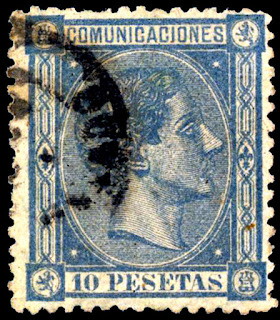Engraved by Jose Garcia Morago Printed in letterpress at the National Stamp Factory.
In sheets of 100 stamps
The reverse has a numeral in blue indicating the position on the sheet.
Genuine Issues Edifil 162-171
Forgeries
Segui Forgeries
Miguel Segui was a stamp forger of Barcelona, Spain, who produced forgeries of Spain and its colonies in 1905.
The most prolific forger of this series is probably Segui
His work is excellent
He normally only made imperforates and unused examples.
His work can be found in multiples.
Common Features
1 "S " letter of "COMMUNICATIONS" is rounded.
2 Small "s" of "Cs" is narrow.
3 Letter "S" from "PESETA" has small head.
4 The three towers of the lower right castle coincide as a vertex.
Sperati Forgeries
The features of the 4 P Sperati forgery:
1) A triangular flaw appears under the tip of the nose
2) The top right of the first "O" of "COMUNICACIONES" is faulty, there is a white dot in the center of the "M" of this word and a white dot in the lower left part of the first "N" of the same word
3) There are also some errors in the word "PESETAS", such as a break in the head of the "P", a break in the bottom of the first "S" etc.
The features of the 10 P Sperati forgery:
1) There is a small break in the bottom of the circular outline of the lower left ornament (with the lion).
2) The bottom of the "P" of "PESETAS" is broken at the left.
3) There is a break in the ellipse above the "T" of "PESETAS".
Postal Forgeries
Postal forgeries were very common in early Spain.
The government did very little about it other than continually issue new stamps and annul old ones.
The government did very little about it other than continually issue new stamps and annul old ones.
 |
| Graus Type III |
..jpg) |
| Graus Type II 9rare unused) |
 |
| Graus Type I |
..jpg) |
| Graus Type II |
 |
| Graus Type I rare used as telegraph stamp |



















